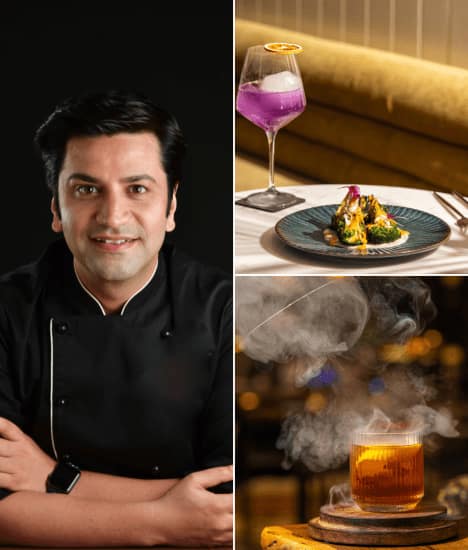Once We Rally Behind Our Own Food, The World Will Follow: Chef Kunal Kapur
The ace chef offers a slice of his experiences, and childhood memories, by melding the vivacity of Indian gastronomy with the lively charm of small-plate dining
If there is one word that describes India’s enduring relationship with food, it is ‘emotion’. Our food is meant to be shared over conversations and laughter, and we do love our meals, no matter how big or small. This is why, for restaurants, Indian food is the perfect platform for experimentation, which is what chef Kunal Kapur’s newest culinary offering, ‘Quarter Plate,’ aims to do. It takes our cultural and culinary vibrancy and serves it in small plates, Spanish Tapas style.
Tapa, which means lid, refers to the small slice of bread that used to be placed on top of beverages at bars to keep things from dropping into the mixture. Small, hot or cold, savoury Spanish dishes today are called tapas. Kapur draws inspiration from the same, with his new restaurant offering a slice of his experiences and childhood memories collected over decades of experience.
Excerpts from a conversation:
 Curry momos
Curry momos
What is the idea behind Quarter Plate?
There is a trend worldwide of savouring more variety, albeit in lesser quantities. That inspired the name Quarter Plate. We wanted to make people travel across India through our culinary offerings. This is why there is kothu parotta from Chennai to pull-apart pav bhaji from Maharashtra places side by side. On one of my travels, I tasted a very different kind of momos that were served with curry. That experience has also made it to the menu, wherein our larger aim is to showcase India’s regional gastronomic variety via small plates. Every plate we serve is a story born from the bustling streets of India.
Is there any personal experience that served as your Eureka moment while designing the menu for Quarter Plate?
As a chef, when you do a menu, you keep certain things for the simple purpose that people will like. And there is another section that is purely from your personal experiences. Our menu here is a collection of my childhood experiences, fond family memories and journeys across India. There is one dish, called Ram Ladoo Ki Chaat, that we serve, which takes me back to my time in Delhi as a child. A person would come on a cycle and serve us chaat that would leak out from the paper it was kept in, so we would rush to devour it. So our rendition of this chaat is my childhood on a plate.
 ‘Oops I dropped my chaat’ is an eclectic dish on the menu
‘Oops I dropped my chaat’ is an eclectic dish on the menu
Another memory is of my father, who loved to cook at home, especially desserts. He would make a custard with fruits and jelly but give it a fancy name. So we have that on the menu, which is an homage to how my father would make it.
Many chefs today are putting the spotlight on regional cuisine. Is this trend here to stay?
With every new trend, there is a lot of excitement attached. Partly thanks to COVID-19, a lot of regional food has made its way into the mainstream. We were home and consumed a lot of information about what and how to cook with what was available around us, and that gave a much-needed impetus to local cuisines across India. For example, 15-20 years ago, Champaran meat was not that common in Patna itself. Still, with migration and growing interest in Indian gastronomy, it has made its presence felt in menus across Delhi. This is a small example of how regional cuisine is riding a wave in India, and we have positioned Quarter Plate on the same lines. It is your ‘ghar ka khana’; some things are entirely authentic, and some dishes have our contemporary spin.
 Quarter Plate in Noida
Quarter Plate in Noida
Food has taken on a new dimension post-pandemic, with many turning into home chefs. What is the future of fine dining in India?
In today’s day and age, where more and more people are eating out, ease of accessibility and diversity of options have made food more loved. Fine dining is taking a backseat, with more casual and innovative culinary establishments rising. Food earlier was a necessity; today, it is an indulgence and therapeutic, which gives us immense joy. This is why fast-casual restaurants have become prominent, and we seek instant gratification.
For a person who cooks and travels so much, is there a cuisine you believe has escaped recognition?
Gujarati and Bengali cuisine I believe, are on another level. The vegetarian food in Gujarat is exceptionally unparalleled. As chefs, we sometimes make food too complicated to make it feel elevated. But Gujaratis use the simplest of ingredients to maximise the taste. Similarly, Bengali food is so vibrant because of its historical and geographical influences and extends far beyond simply macher jhol and mishti doi.

Today, many Indian restaurants are being appreciated abroad. Do you believe Indian cuisine is getting its due?
There is a definite shift, but we are far from being the best. Are we counted among mainstream restaurants abroad? Yes. But are we the first choice for non-Indians? No. And that is not my focus area either. My focus is to have more Indians appreciate their food. If my patron stays in Noida and has not tasted the food of Nagaland or West Bengal, then that is the food I’d like to serve in my restaurants. I would love more Indians to recognise their culinary diversity. I believe once we rally behind our own food, the world will follow suit.












